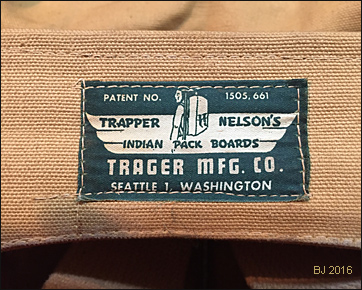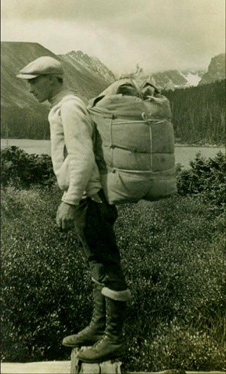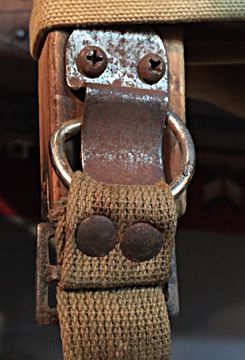

Some 30 years before Dick Kelty began making his iconic aluminum-framed Kelty packs, a Seattle man named Lloyd F. Nelson filed his patent application for what would become an iconic early-era external frame pack. The date was July 31, 1922. The patent application was composed by Seattle attorney Richard J. Cook (1881?-1946).
The pack was an invention of Lloyd F. Nelson (1894?-1986). Nelson spent much time in research and development of his "Trapper Nelson's Indian Pack Board." It met with great commercial success and in the history of packs in the U.S. was the first-ever mass-produced external-frame pack. The first of them began to be sold in 1924. The Trapper Nelson essentially relegated previous frameless packs like the Duluth pack to the history books (see image of Roy Holubar below)
Users found it to be, if not particularly comfortable under heavy loads, at least very sturdy and reliable. By 1929, Mr. Nelson made a deal with Trager Manuf. Co. to produce the packs, and they were of very high construction quality (see pictures). At some later times, the packs were made by Canadian manufacturers like Pioneer.
Inspired by the considerable pain and
discomfort he experienced while hiking with a borrowed Inuit-made
sticks-and-sealskin backpack while visiting Alaska in 1920, Bremerton's
Lloyd F. Nelson began thinking about how to design and make a
different kind of pack than the all-cloth (or leather) rucksacks that
were then available back home and popular among hunters and backwoods
fishermen. (image: LeRoy
Holubar hauling the kind of "kidney
buster" pack which Mr. Nelson sought to improve on. Picture
dates from about 1928. By the 1950s, Holubar
Mountaineering Ltd. was selling much-improved packs with aluminum
frames).....Mr. Nelson's thoughts and experiments led to a type
of pack that had not previously existed.
that
were then available back home and popular among hunters and backwoods
fishermen. (image: LeRoy
Holubar hauling the kind of "kidney
buster" pack which Mr. Nelson sought to improve on. Picture
dates from about 1928. By the 1950s, Holubar
Mountaineering Ltd. was selling much-improved packs with aluminum
frames).....Mr. Nelson's thoughts and experiments led to a type
of pack that had not previously existed.
The central conceptual breakthrough of
the Trapper Nelson design was to create a stabilizing wooden pack-frame
(or "pack board") upon which would be attached a canvas
backband meant to cushion the wearer's back. Also of note was
a canvas packbag that was attached to the frame with long steel
pins to allow for easy detachability for cleaning, or to allow
the user to lash large bulky loads to the frame itself.. The whole
pack was held close to the hiker's body with two canvas shoulder-straps.
In short, the pack was sturdy, reliable, and simple. There was
no waist belt for load-transfer to the hips...
Mr. Nelson began production of the pack by hiring townsfolk in
Bremerton to make pack components and assemble them.
But initially sales were rather slow because, at the time of the Trapper Nelson invention, wilderness hiking had not quite yet become a widely popular outdoor activity for mainstream Americans. The first big sale that really got the fledgling company off the ground was 1000 packs to the predecessor of the US Forest Service... The pack was geared toward sportsmen, U.S. Forest Service firefighters, and then Department of the Interior and U.S. Geological Survey teams, and eventually military personnel. But by the 1930s the Boy Scouts of America discovered the positive attributes of the "Trapper Nelson." Packs made for the Scouts in the 50s and 60s had an imprinted "BSA" logo prominently on the front flap. In time the general public's fondness for nature, hiking, and camping vastly increased. Today Lloyd F. Nelson could be considered one of the fathers of the modern backpack. His pack helped motivate many people to try out wilderness journeying, and ultimately contributed to the love of the wilderness so prominent in the environmental movement.
-- major story sources: Wikipedia, my own photography and my own prior history of gear research
Please Note: All Material on this page, and in all my "History of Gear" webpages, is copyrighted, and no usage of my material is permitted unless explicit permission is granted by me, Bruce B. Johnson, owner of OregonPhotos.com. The pictures and research are all my property. . Editors: Please contact me if you have interest in publishing....Others: if you were involved with one of the old-line, vintage gear companies and have a story to tell in these pages, please contact me soon at brucej@Oregonphotos.com



All photography copyrighted Bruce Johnson. In the center picture we see leather conchos (rivet reinforcements).
 only
one zipper
only
one zipperThe popularity of Trapper Nelson pack boards was already waning in 1965, when I bought my first aluminum-framed backpack. However, the packs continued to be made by Trager up until 1986. Reportedly, the packs continue to be highly popular with Alaskan hunting guides and prospectors, who consider them superior to modern aluminum frames for carrying the heavy loads that are often part of those activities.
Remarkably different has been the business course of the small custom gearmaker Stephenson's Warmlite, which has survived, and never changed its name or ownership in some 40 years of doing business! Jack Stephenson, an aerospace engineer, created what was arguably the first true hip-carry pack in the late 1950s.
HISTORY OF GEAR BOOKS!
My book about Frostline Kits has been updated since the death of its founder Dale Johnson in 2012. PLEASE VISIT MY FROSTLINE PAGE . ...My second book in the History of Gear series tells the story the story of GERRY Mountain Sports, and is titled "GERRY, To Live in the Mountains." It was released May 2008. The third book in the series reveals the life and times of Roy and Alice Holubar, and is titled "Holubar Mountaineering Ltd." The writing of the Holubar book had lots of help from its ex-President Jim Kack, from Roy and Alice's daughter, and also from numerous other ex-Holubar staff. I've also more recently added books about Stephenson's Warmlite and Mountain Safety Research (MSR).